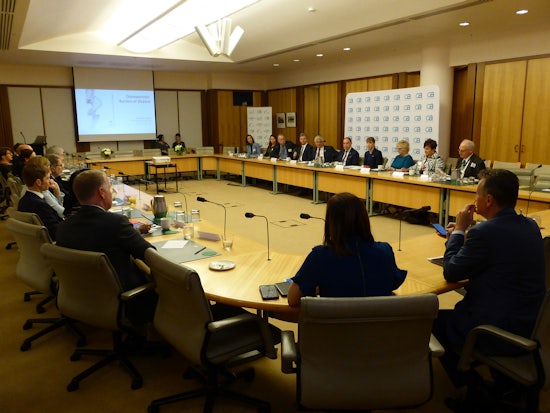Under-diagnosis of osteoporosis a risk for older Australians
The prevalence and under-diagnosis of osteoporosis among older Australians and the associated risks are among the concerns being raised and addressed as part of Australia’s World Osteoporosis Day campaign.

The Osteoporosis Australia Roundtable in Canberra on October 19 (Source: Osteoporosis Australia)
The concern comes from Osteoporosis Australia who report that 66 percent of the population aged over 50 are estimated to have poor bone health, with hip fractures remaining to be the most costly type of fracture related to osteoporosis and other fracture types such as wrist, spinal, arm and leg fractures remaining to be widespread.
Chief Executive Officer Osteoporosis Australia Greg Lyubomirsky says that after repairing a costly fracture for any patient over 50, we need to be asking…’why did it happen?’
“Osteoporosis Australia, along with many medical experts in Australia, are deeply concerned that the majority of Australians are not investigated or diagnosed with osteoporosis leading to an excess of fractures related to osteoporosis,” he says.
“Fractures are mostly caused by osteoporosis in people aged over 50, yet only 20 percent of these patients are currently being investigated.
“Therefore, most patients are not being diagnosed, and remain unaware of their underlying health issue.
“What is important to note about osteoporosis is that it affects men and women… and it’s important that people with risk factors for osteoporosis are investigated with a bone density test.
“We cannot allow so many Australians to be affected by broken bones – we must take action to prevent fractures.”
Professor Mark Cooper, Deputy Chair of the Osteoporosis Australia Medical Committee says change to the investigation and treatment processes need to happen.
“We have patients leaving hospitals after sustaining a fracture who are not routinely investigated for osteoporosis,” he says.
“We also have members of our community living with osteoporosis risk factors, who are not having a bone mineral density test.
“This must change so that we can prevent fractures.”
Minister for Aged Care Ken Wyatt spoke at the Osteoporosis Australia Roundtable in Canberra ahead of World Osteoporosis Day (20 October), to review the impact of osteoporosis in Australia and investigate strategies for fracture prevention.
“This year’s World Osteoporosis Day theme is ‘Love Your Bones’, a timely reminder of the importance of prevention, with estimates that more than one million Australians may already be suffering from osteoporosis.” Minister Wyatt says.
“Early diagnosis and treatment of this chronic condition is the best way to reduce the chance of serious fractures and the broader impacts of broken bones in later years.
“Research shows that older people with hip fractures are over three and a half times more likely than their non-injured counterparts to die within 12 months.”
At the Roundtable in Canberra Minister Wyatt also shared that three-quarters of people with the condition are women.
“About one million older Australians have at least one fall each year and about 40-60 percent will sustain major injuries including broken bones,” he says.
“What we know as the ‘fall cascade’ is a significant issue for people with osteoporosis, because once they have had one fall, there is a very great likelihood they will have another fall within the next 12 months.”
In recognition of this, Minister Wyatt says the Government has provided funding to Osteoporosis Australia for a pilot study to investigate re-fracture prevention and develop a best practice model for sustainable, integrated and national re-fracture prevention program.
The Minister is also urging Australians of all ages to complete a simple, online bone health check, to prevent potentially crippling conditions, as they grow old.
Mr Lyubomirsky also recommends the online bone check and adds that for people of all ages maintaining bone health is important and means adequate calcium, vitamin D and exercise, but for those already diagnosed with osteoporosis, he says medication is required to prevent further fractures.
“Once a fracture occurs, it is critical to discuss diagnosis with your doctor and start medication to avoid further fractures,” he says.
“Therefore, to better understand your risk of poor bone health, visit Know Your Bones and do an online bone health self-assessment.
“The self-assessment will provide a report showing results and risks which can then be discussed with your doctor.”























